In this article, let’s get into growing strawberries in containers. You can grow strawberries anywhere, whether you live in a bustling city or quiet suburb. Thinking about space constraints? Let me tell you, container gardening is the ideal solution for those facing space constraints and lack of room. But you have to choose the right variety of strawberry for your area – be it for Florida’s heat or Michigan’s cool. Choose one that grows well in your weather, select the right pot and look after it. These simple steps are all you need to do.
If you are eager to learn about growing these berries at home and making a place for fresh, juicy strawberries, keep reading. By the end, you’ll have every information to grow strawberries in containers successfully.
Benefits of Growing Strawberries in Containers
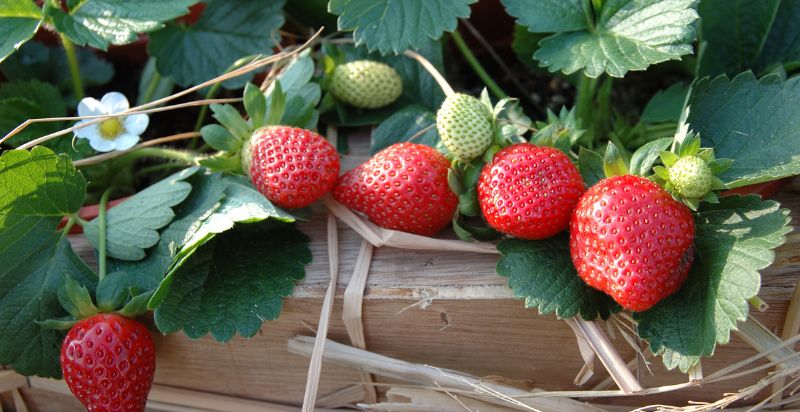
The benefits of growing strawberries in containers are many, read them below.
- Space Efficiency: Ideal for gardeners with limited space. Containers can be placed on balconies, patios, or even windowsills, making the most of small areas.
- Portability: Containers are easily movable. This feature is particularly useful for adjusting the plant’s exposure to sunlight and sheltering them from harsh weather conditions.
- Soil Control: Growing in containers allows for complete control over the soil quality. This is crucial for strawberries, which thrive in well-drained, nutrient-rich soil.
- Reduced Pest and Disease Risk: Elevated containers can help minimize the risk of soil-borne diseases and pests, leading to healthier plants and cleaner fruit.
- Aesthetics: Strawberry containers add visual appeal to any space. They can be used as decorative elements in garden design, bringing beauty and functionality together.
- Accessibility: Ideal for those with mobility issues. Container gardening eliminates the need for bending or kneeling, making strawberry growing accessible to everyone.
- Extended Growing Season: Containers can be moved indoors or to sheltered areas during extreme weather, potentially extending the growing season and protecting plants from frost.
- Personal Satisfaction: There’s a unique joy in nurturing and harvesting your own strawberries. It’s a rewarding experience that connects you with nature, even in an urban setting.
- Variety and Experimentation: Allows for growing different varieties in separate containers, making it easier to experiment and learn which types thrive best in your environment.
Steps to Grow Strawberries in Containers
Follow these steps to grow your strawberries successfully in containers.
Choosing the Best Container
When it comes to growing strawberries, the container you choose is crucial for their health and growth. Let’s talk about what works best.
First off, let’s think about size. Any type of container that is large enough to accommodate the roots of your strawberry plants and has drainage holes in the base will be suitable. If it’s too small, they’ll get cramped and won’t grow well.
The container size will depend on the number of strawberry plants you want to grow. Generally, each strawberry plant will need a pot at least 20cm (8in) wide and deep. If you are growing several plants in one pot, make sure it is at least 40cm (16in) wide and deep.
Next, consider the material. Here are some options you can consider.
Plastic pots:
They are a popular choice due to their lightweight and affordability. They’re great at retaining moisture, which is beneficial for plants that need consistent watering. However, they can sometimes hold too much water, so make sure they have good drainage.
Terracotta and clay pots:
They are the go-to for gardeners who prefer a more natural look. They’re excellent at allowing air and moisture to move through the soil, reducing the risk of root rot. But remember, these pots can dry out quickly, so they might need more frequent watering, especially in hot climates.
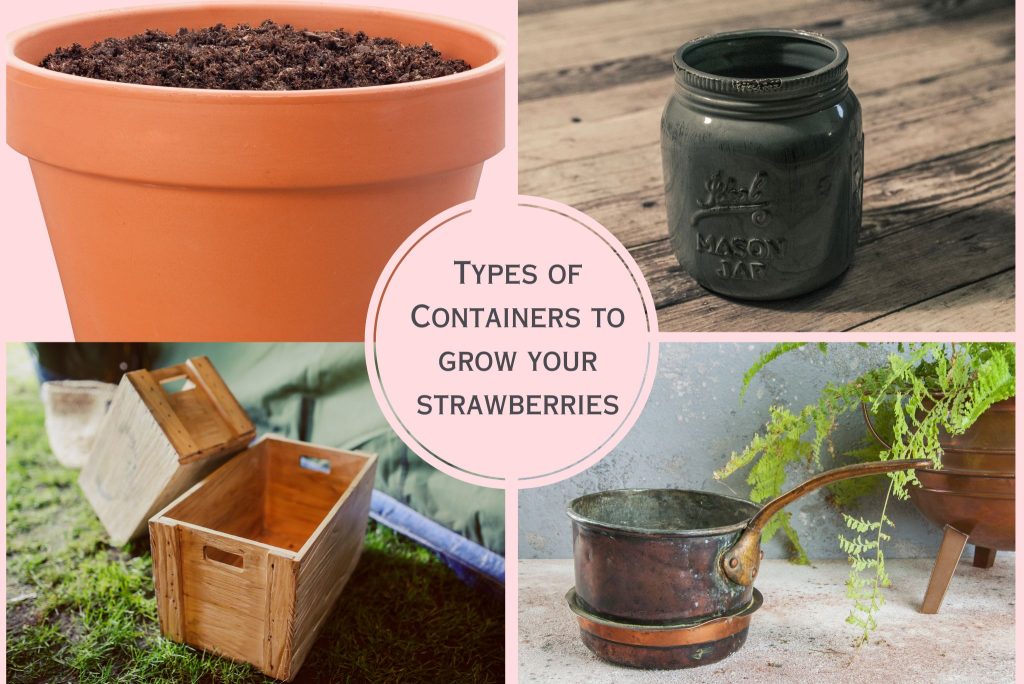
Wooden containers:
These offer a rustic charm and are good insulators for plant roots. Just be mindful that they can rot over time, especially if they’re not treated or lined with a protective layer.
Metal pots:
Planting strawberries in metal pots can create a modern feel in your garden space. They’re durable but can heat up quickly in direct sunlight, which might not be ideal for some plants.
In choosing the right material, consider your plant’s watering needs, your local climate, and how much time you can dedicate to your garden. Each material has its pros and cons, so think about what works best for your gardening style and the specific needs of your plants.
Drainage is super important too. You don’t want your strawberries sitting in waterlogged soil – they’ll rot! Make sure your container has plenty of drainage holes at the bottom. Now, speaking from my own experience, I’ve found that hanging baskets work really well for strawberries. They save space, keep the fruits off the ground (away from pests!), and look pretty too! Well, here is a tip: choose a light-colored pot, as dark colors absorb heat, which can scorch the roots of your plants.
Preparing the Container
Fill your tub or container with compost to 10cm (4in) of the rim. Use a good quality potting compost, such as John Innes No.3, specially formulated for containers. If you are reusing a pot that has previously been used for another plant, make sure you clean it out thoroughly before adding fresh compost.
Water the compost well and allow it to drain before planting your strawberry plants. If you are using a terracotta pot, soak it in water for at least an hour before planting to help prevent the pot from drying out too quickly.
Preparing the Soil
So, what kind of soil do strawberries like? Well, they’re not too picky, but they do have their preferences. You’ll want to go for a potting mix that’s light and fluffy, kind of like a cloud. This helps the roots breathe and allows water to drain properly, preventing soggy soil that could drown your plants.
I’ve found that a mix of peat moss, perlite, and compost works wonders for my strawberry pots. It’s like a nutrient-packed smoothie for the plants – they gobble it up and thrive! You can find them at your local garden center or online. Plus, adding a bit of compost gives them that extra boost of vitamins and minerals they need to produce juicy, delicious berries.
When preparing the soil for your strawberries, it is important to avoid using fresh manure, which can contain harmful bacteria that can infect your plants. If you must use manure, ensure it is well-composted and has been used on other crops first. Give your soil a little TLC too – check it regularly to make sure it’s not too dry or compacted. And yes, plenty of sunshine and water too!
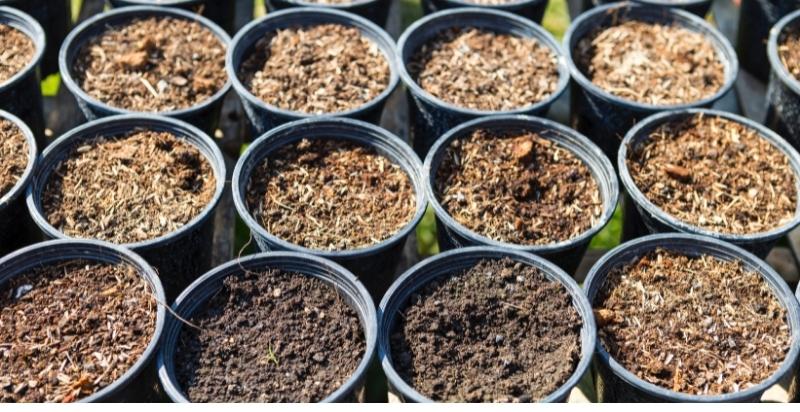
Planting Your Strawberry Plants
Ah, the question of when to plant strawberries in containers – it’s a bit like timing a perfect cup of tea, planting at the right time is how you get those sweet, juicy berries we all love.
For most regions, the ideal time to start is early spring, just after the threat of frost has passed. You want to make sure your young strawberry plants don’t get nipped by a late frost. In warmer areas, like those sunny southern states, you could even start in late winter. The plants get a head start and avoid the scorching mid-summer heat.
But here’s a pro tip: if you’re an eager beaver and want to start even earlier, you can! Just keep your containers indoors or in a protected area until the weather warms up. Remember, strawberries are a bit like us when it comes to enjoying the weather. They love those sunny, mild days of spring and fall.
Choose healthy-looking plants that are free from pests and diseases. Dig a hole in the compost to accommodate the roots to plant your strawberry plants. Gently loosen the roots and position the plant in the hole so that the crown (where the leaves meet the stem) is level with the surface of the compost. Fill in around the roots with compost and firm gently. Water your plants well after planting and keep them moist throughout the growing season.
If you are growing strawberries from seed, sow the seeds in late winter or early spring.

Harvesting Your Strawberries:
Strawberries are ready to harvest when fully ripe and have turned a deep red color. To test if they are ready, gently press down on the fruit with your finger. If it is soft enough to dent, it is ready to pick.
Cut the stem with a sharp knife or secateurs; leaving a small part of the stem attached. This method helps to keep the berries fresh for longer. It’s best to harvest in the morning when the berries are still cool. This keeps them fresher and extends their shelf life. If you need to store them, put them in the fridge, where they will keep for a few days.
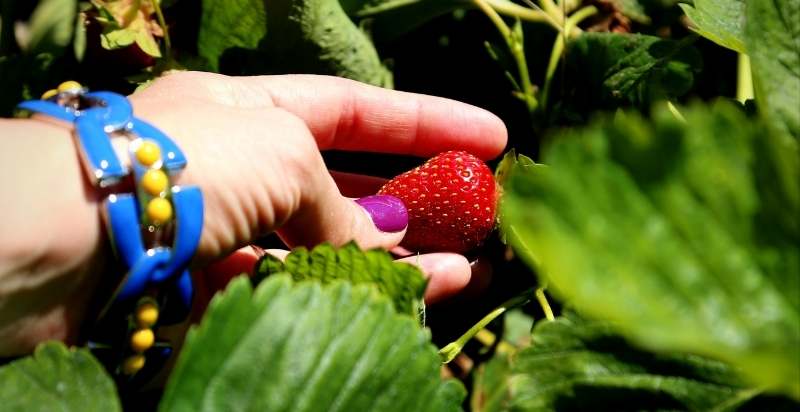
Enjoy your strawberries as soon as possible after picking the best flavor. Once you’ve harvested your strawberries, the fun part begins – enjoying them! There’s nothing quite like the taste of fresh strawberries straight from the garden. You can eat them as they are, add them to breakfast cereals, or use them in smoothies. I love making homemade strawberry jam, which is a great way to preserve their flavor. Strawberry shortcake, salads, and even savory dishes like strawberry balsamic chicken are just a few of the creative ways you can enjoy your harvest.
What Type of Strawberry is Best for Pots?
The best strawberries to grow in containers are known as ‘alpine’ or ‘everbearing’ varieties. These include ‘Mara de Bois’, ‘Temptation’, ‘Sweetheart’, and ‘Aromas’.
Regional Adaptations:
In the warm climates of Texas and Florida, opt for heat-tolerant strawberry varieties like ‘Festival’ or ‘Chandler.’ These regions benefit from early planting, ideally in late winter, to avoid the intense mid-summer heat.
Georgia’s climate is similar, but with slightly cooler temperatures, varieties like ‘Sweet Charlie’ and ‘Georgia Belle’ thrive. In Arizona, with its dry conditions, regular watering is crucial. Varieties like ‘Sequoia’ are recommended, and it’s beneficial to provide some afternoon shade to protect the plants from extreme heat.
Moving north to Michigan, cold-hardy varieties like ‘Honeoye’ and ‘Allstar’ are ideal. Planting should be done after the last frost, usually in late spring, and consider using mulch for winter protection.
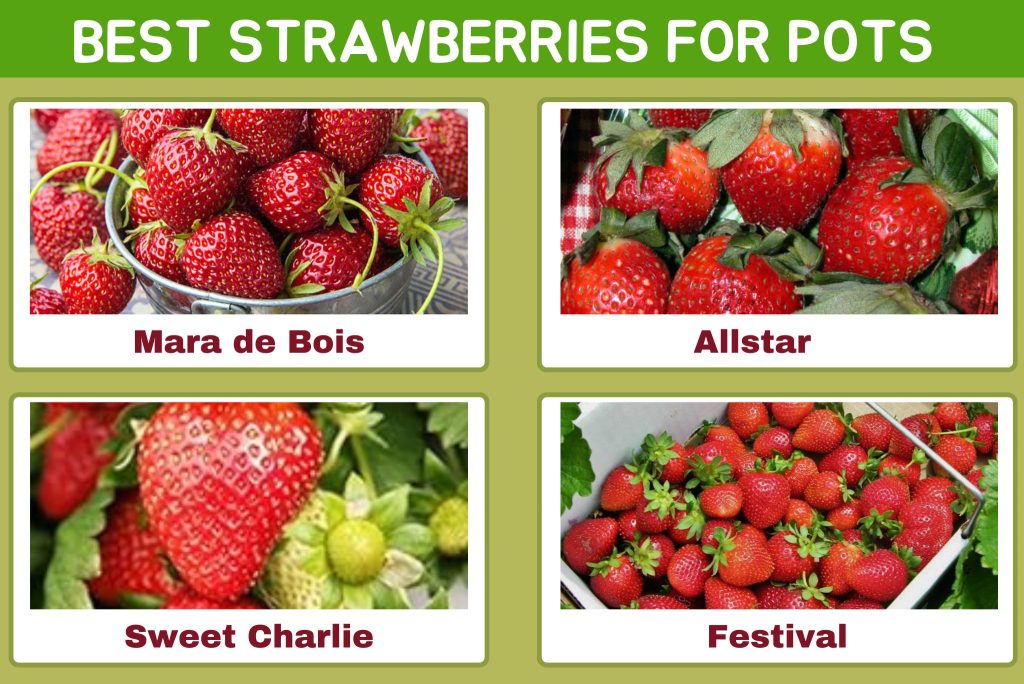
Alpine strawberries are smaller than the more familiar varieties you see in supermarkets, but they more than make up for their size with their intense flavor. They are also effortless to grow, which makes them ideal for beginner gardeners.
In the diverse climates of the UK and Australia, strawberry growing can vary. In the UK, where summers are milder, ‘Elsanta’ and ‘Cambridge Favourite’ are popular choices. In Australia, particularly in cooler areas like Melbourne, ‘Alinta’ and ‘Redlands Joy’ are excellent choices. Planting times in Australia vary from early spring in cooler regions to mid-winter in warmer areas.
Each region has its own challenges and advantages. By choosing the right variety and giving the appropriate care, you can enjoy delicious homegrown strawberries no matter where you garden.
Zone-Specific Advice:
Growing strawberries in containers can be a delightful experience, but it’s important to tailor your approach to the specific zone you’re in. Each climate zone has its quirks, and understanding these can make a big difference in your strawberry-growing success.
In cooler zones, like Zones 3-5, your main challenge is the shorter growing season and the risk of frost. For these areas, choosing cold-hardy varieties like ‘Fort Laramie’ or ‘Honeoye’ is wise. You’ll want to start your strawberries early indoors or in a greenhouse and then move them outside once the threat of frost has passed. In these zones, maximizing sun exposure is crucial, so place your containers in the sunniest part of your space.
Moving to the middle zones, like Zones 6-7, you have a bit more flexibility. These areas enjoy a longer growing season so that you can plant a wider range of varieties. Everbearing strawberries are a good choice here, as they’ll provide a steady supply of berries throughout the season. Regular watering and mulching to retain soil moisture are key in these zones.
For the warmer zones, like Zones 8-10, heat tolerance becomes the priority. Varieties like ‘Chandler’ or ‘Sweet Charlie’ are well-suited to these conditions. In these zones, you’ll want to get your strawberries started in late winter or early spring to avoid the peak summer heat. Providing some afternoon shade can help protect the plants from scorching temperatures.
No matter your zone, remember that container gardening offers the advantage of mobility. If a sudden cold snap or heatwave hits, you can move your strawberries to a more protected spot. With a bit of zone-specific care, you can enjoy a bountiful strawberry harvest right from your container garden.
Where to Buy Strawberry Plants?
Strawberry plants are available from garden centers and online retailers from late March onwards. If you buy plants that have already been grown in pots, they can be planted straight into their final home. Strawberry plants are usually available to buy from early spring onwards.
If you are buying bare-rooted strawberry plants, they will need to be prepared before planting. To do this, soak the roots in water for an hour or so before potting them up, and this will help them to establish more quickly once they are in the pot. Now comes the fun part :
Caring For Your Strawberry Plants
Strawberry plants need to be kept moist but not waterlogged, so check the compost regularly and water when necessary. You may need to water your plants daily during hot, dry weather. Feed your strawberry plants every two weeks with a high-potash liquid fertilizer such as tomato feed. This will encourage fruiting.
If you’re growing them on a balcony or patio, make sure they’re positioned to get enough light. If you’re growing them indoors, a sunny windowsill or a grow light can do the trick.
Remove any flowers that appear in the first year to encourage your plants to produce more fruit. In the following years, allow some flowers to set fruit, but remove any that appear later in the season so that the plants can put all their energy into ripening the fruits already developing.
Feeding your strawberries is also important. Use a balanced, all-purpose fertilizer every few weeks during the growing season. This will provide them with the necessary nutrients to grow and produce fruit.
Once the flowers have opened, you can help to prevent them from being blown away by the wind by tying them together with soft string or strips of fabric.
When the fruits start to swell, put a layer of straw around the plants to protect the fruits from contact with the soil, which could cause them to rot. Lastly, as the season progresses, you’ll need to prune and deadhead your plants. Remove any dead leaves and spent flowers to encourage new growth and fruit production.
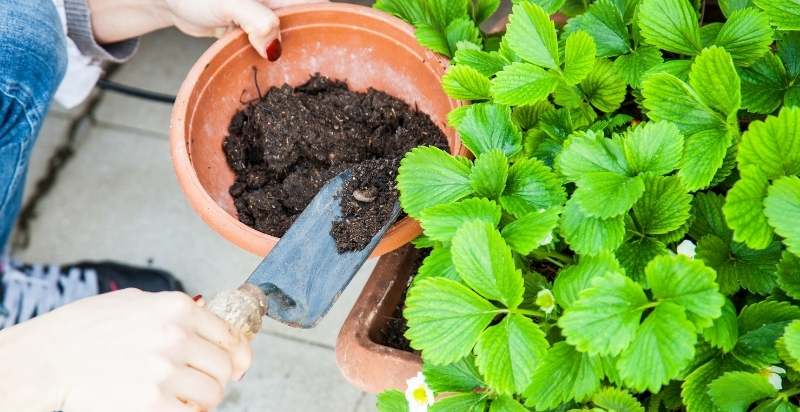
Overcoming Challenges: Pests, Diseases, and Common Issues
Growing strawberries in containers can sometimes feel like a bit of a battle against nature, especially when it comes to dealing with pests and diseases and adapting to challenging conditions. I remember my first encounter with aphids on my balcony-grown strawberries; it was a real eye-opener to the vigilance required in container gardening.
Pests like aphids, spider mites, and slugs are common foes. Regular inspections are key. For aphids and mites, a gentle spray of water or insecticidal soap can work wonders. Slugs, on the other hand, are a bit trickier. I found that setting up beer traps around my pots was an effective, if somewhat unorthodox, solution. By the way, eggshells are a good remedy to keep the slugs away.
Diseases such as powdery mildew and root rot are also prevalent, especially in humid conditions. Good air circulation is crucial to prevent these. I learned to space my pots adequately and prune the plants to ensure air could circulate freely. For indoor growers, managing humidity levels is vital. Using a dehumidifier or ensuring adequate ventilation can help mitigate these risks.
The most common problem with strawberry plants is that they are susceptible to a fungal disease called gray mold (Botrytis cinerea). This can cause the fruits to rot and the leaves to turn yellow and die back.
To prevent gray mold, water your plants at ground level rather than wetting the foliage, and ensure good air circulation around the plants. Remove any affected leaves and fruits as soon as you see them.
Another problem that can affect strawberry plants is root rot caused by overwatering. The easiest way to prevent this is to ensure that the pot has drainage holes in the bottom and that you only water when the compost is dry. In the picture below, you can view some of the diseases affecting strawberry leaves.

If you need help managing diseases in your strawberries, refer to the Pacific Northwest Plant Disease Management Handbook.
Companion Planting: What to Plant with Strawberries in a Container
Companion planting is like having good neighbors for your strawberries in their container homes. It’s about choosing plants that can live together and help each other out. When you pick the right companions for your strawberries, you can improve their growth and even keep some pests away. Here’s a simple guide on what to plant with your strawberries in a container:
- Herbs: Some herbs are great buddies for strawberries. For example, borage is known to repel unwanted insects and can improve the flavor of your strawberries. Then there’s thyme, which, with its pleasant scent, can deter worms from bothering your strawberry plants.
- Flowers: Flowers aren’t just pretty; they can be quite useful too. Marigolds are a popular choice because they repel nematodes and other pests that might harm your strawberries. Another good option is nasturtiums. They act like a magnet for aphids, luring them away from your strawberries.
- Vegetables: Believe it or not, some veggies can be good companions too. Lettuce, for instance, can be planted around the base of your strawberry plant. It doesn’t compete much for space or nutrients, making it a peaceful cohabitant.
Remember, while companion planting can be beneficial, it’s also important not to overcrowd your container. Each plant needs its own space to grow. So, choose one or two companions and see how they help your strawberries flourish. It’s like creating a little community in your container where each plant supports the other.
Sustainable and Creative Gardening
Sustainable and creative gardening utilizing everyday items to grow strawberries has its own benefits. Let us explore some of them in the table below:
| Item | Benefits |
| Recycled Containers (milk bottles, plastic water bottles, and shipping containers) | – Cutting out a side of a milk bottle or a water bottle can give you a neat little pot – Shipping containers, on the other hand, can be converted into large raised beds or even mini greenhouses |
| Fabric Pots | – Great for root aeration and super lightweight |
| Mason Jars and Plastic Bottles | – Mason jars are ideal for herbs and small plants – Plastic bottles can be cut and used for starting seedlings |
| Raised Planters and Stackable Containers | – Raised planters are excellent for back-friendly gardening and keeping pests at bay – Stackable containers are space-savers, letting you grow vertically |
| Wall Planters | – Great for small spaces |
| Hanging Containers | – Perfect for balconies or patios and can be made from upcycled materials like old baskets or bottles |
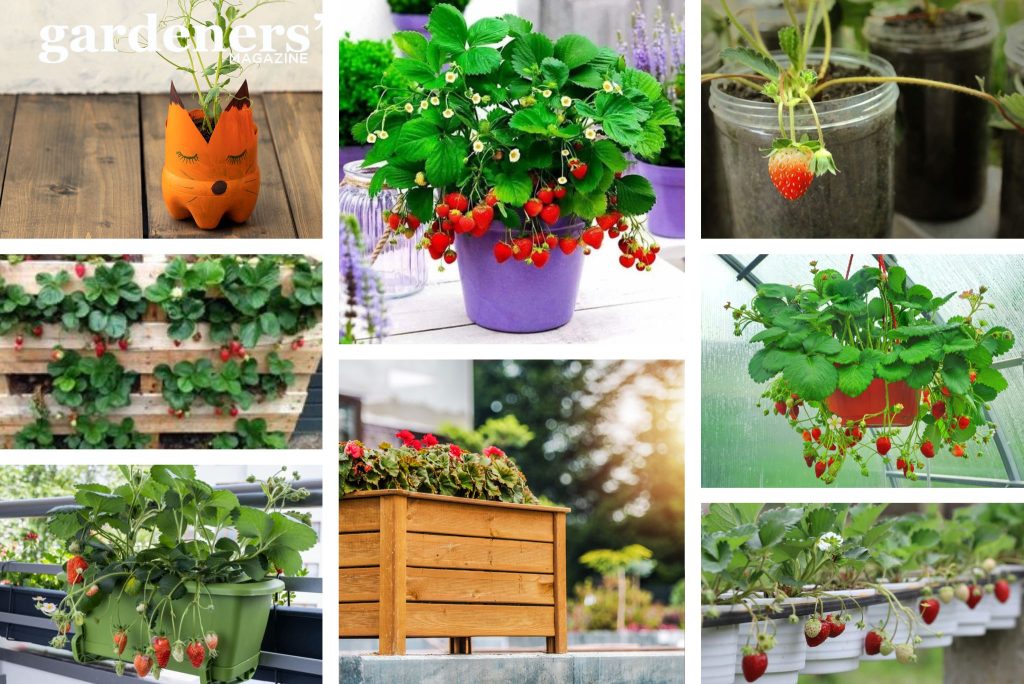
Using these sustainable and creative gardening methods, you’re not just growing plants; you’re also doing your bit for the environment by recycling and reducing waste.
Winter Care and Repotting
When winter rolls around, taking care of your strawberry plants in containers needs a bit of extra attention. Different climates call for different strategies. Plus, repotting and transplanting are key to keeping your strawberries happy and healthy. Let me share some tips based on my own gardening experiences.
Overwintering Strategies:
- Mild Climates: If you live in an area with mild winters, it’s usually enough to move your containers to a sheltered spot. This could be against a wall or under a porch. The goal is to protect them from harsh winds and extreme cold snaps.
- Cold Climates: In areas with harsh winters, you’ll need to provide more protection. I usually move my pots into an unheated garage or shed. If that’s not an option, wrapping the pots in burlap or bubble wrap can provide insulation. Don’t forget to check the soil moisture occasionally; it should be dry but not completely parched.
Repotting and Transplanting:
- When to Repot: The best time to repot is in the early spring, just before the growing season starts. If your plants have outgrown their pots or the soil looks exhausted, it’s time for a change.
- How to Do It: Gently remove the plant from the old pot. If you’re dividing the plant, use a clean, sharp knife. Make sure each section has some roots and a few leaves. Then, plant them in fresh potting soil in a new container, giving them enough space to grow.
Remember, strawberries like their space, so don’t overcrowd them in the new pot. Also, after repotting, give them some time to adjust before the full swing of the growing season. With these simple winter care and repotting strategies, your strawberries will be ready to burst into growth once spring arrives.
How Many Strawberry Plants Per Person?
When you’re planning to grow strawberries, a common question is: How many plants do you need per person to ensure a steady supply of these juicy fruits? Well, it’s not a one-size-fits-all answer, but let’s try to break it down.
Typically, a single strawberry plant can yield about one quart of strawberries per season. If you’re just looking to enjoy a few fresh berries now and then, maybe in your morning cereal or as a healthy snack, planting about three to four plants per person should suffice.
However, if you like to consume more of them, relishing them in daily smoothies, desserts, or perhaps wanting to make some homemade jam, you might want to scale up. In this case, consider planting about six to ten plants per person.
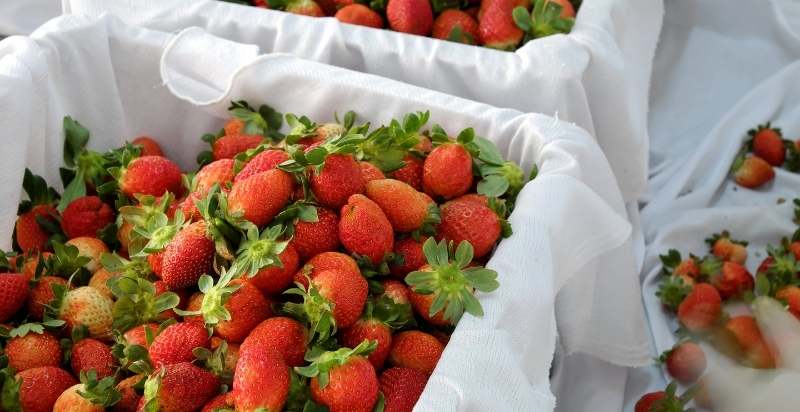
Remember, these are just guidelines. The actual yield can vary based on factors like the strawberry variety, the growing conditions, and how well the plants are tended to. So, it’s always good to start with these recommendations and then adjust as you learn more about your plants and your own strawberry consumption habits.
Conclusion
As we come to the end of our container gardening adventure, remember, the journey with your strawberries is just beginning. Container gardening is a canvas for creativity and experimentation. It’s about enjoying the process, watching your plants grow, and learning from each little leaf and berry. Don’t be afraid to try new things, mix up your methods, and see what works best for you and your plants.
And most importantly, have fun with it! I’d love to hear about your container gardening escapades – what worked, what didn’t, and any surprises along the way. Feel free to share your stories or ask questions. Let’s keep growing and learning together in this wonderful world of container gardening!
- Lulo: Description, Flavor, Benefits, And Uses - March 19, 2024
- Banana Leaves: Benefits, Uses, Growing Tips & Cultural Information - March 11, 2024
- How to Grow Strawberries Successfully in Containers - March 8, 2024
